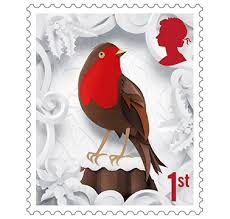Every year the Royal Mail issues a collection of Christmas postage stamps. Its set for 2016 depicts six of the corniest Christmas clichés — snowman (2nd class post), robin (1st class post), tree (£1.05), lantern (£1.33), stocking (£1.52) and pudding (£2.25).
Unfortunately, the representation of the Robin on the first class stamp is far from first class. The image may be roughly the right shape for a Robin, but the bird has been given a breast of a garish pillar-box red rather than the more subtle orange-red of a real adult Robin. Even worse, the chocolate brown around and below this bib is quite wrong. In real life the Robin’s colourful breast patch has a delicate bluish-grey margin either side of it, and the bird’s undercarriage is whitish from the belly to beneath the tail, shading into pale reddish-brown on the flanks. Only the upperparts and wings are actually brown.
The stamp also gives its Robin yellow legs, a yellowish bill and a conspicuous white eye with a tiny black pupil. In fact the legs and bill should be brown and the eye is entirely black, surrounded by a fine white eye-ring.
Examining this rotten representation of a Robin set me thinking about why the bird has become a Yuletide symbol. One alleged origin for its association with Christmas lies in maudlin folklore linking its red breast to either the birth or the death of Jesus. One legend says that when ickle baby Jesus was in his manger in the stable, the fire lit to keep him warm began to die down. A little brown bird flew in and flapped its wings to make the embers glow and re-ignite the fire. A stray red-hot ember flew from the hearth, landing on the bird’s breast to make it glow bright red. An alternative version has the fire flaring up and the bird scorching its breast by placing itself in front of the fire to protect the baby Jesus. In either case, Mary supposedly declared that the reddened breast was a sign of the bird’s kind heart and that the bird and its descendants would wear a red breast proudly for evermore.
Equally nauseating is the story that when Jesus was dying on the cross a Robin flew up and tried to remove his thorny crown. But it was not strong enough and its passionate attempts led to its breast being stained red with Jesus’s blood.
A more plausible origin for the Robin’s association with Christmas derives from the nickname “Robin” given to Victorian postmen because of their red tunics. (Red is, of course, still used by the Royal Mail on its logo, postboxes, vans, etc.) Because people expecting Christmas mail eagerly awaited the arrival of the red-breasted postman, some greeting card artists illustrated their cards with images of postal delivery. However, one artist decided that instead of drawing Robin the postman, he would draw Robin the bird with letters in its little beak. The trend caught on and, as Victorian tastes grew more extravagant, Robins were even slaughtered to provide red feathers for decorating cards.
Incidentally, the name Robin is a fairly recent acquisition, only officially accepted by the British Ornithologists’ Union in 1952. The bird’s Anglo-Saxon name was Ruddock, but by the Middles Ages it had become known as Redbreast. In the 16th century there was a fad for giving common birds personal names, so that the Daw became Jack Daw, the Pie became Mag (Margaret) Pie, the Wren became Jenny Wren, tits became Tom Tit, etc, and the Redbreast became Robin Redbreast. Over the years, Jack Daw and Mag Pie condensed to Jackdaw and Magpie, and the Wren and the tits dropped their adopted forenames. But the Redbreast went on to lose its “surname” and become just plain Robin.


No comments:
Post a Comment